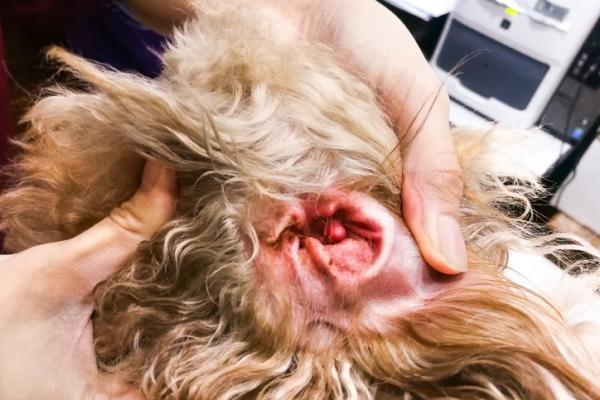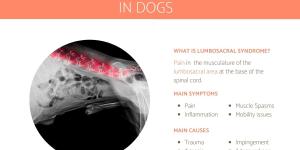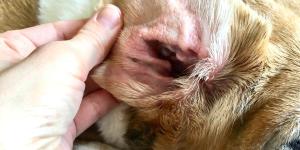My Dog's Ear Is In Pain - Causes and Pain Relief



See files for Dogs
Otitis is a relatively common problem in veterinary clinical practice. A general term for many types of ear inflammation, otitis manifests in itching, redness, excess wax build up and ear pain in the dog. This both causes discomfort in the dog, but also worry in the guardian. Despite its prevalence, otitis is not the only cause that can explain the discomfort that your dog feels in the ear, whether it is the external or the internal part.
In this AnimalWised article, we understand why my dog's ear is in pain. We look at the causes of ear pain, as well as the possible treatment options for pain relief.
Causes of ear pain in dogs
The main cause of ear pain in dogs is otitis. This is a general term for ear inflammation, of which there are different types. We will examine otitis in more detail below, along with other reasons your dog may have ear pain.
Otitis in dogs
The ear is made up of the inner, middle and outer ear sections. The outer ear consists of the ear pinnae and the ear canal. Otitis is an inflammation of any sections of the ear, meaning we can have external, internal or middle-ear otitis. External otitis in dogs is the most common type. If neglected or treated insufficiently, it can progress medially and/or internally, causing more serious problems. These can further manifest into neurological symptoms.
Otitis inflammation produces pain. Another very common sign of otitis is increased production of cerumen (ear wax) by the ceruminous glands. If your dog shakes or tilts their head, scratches their ear excessively, has excessive earwax or has an unpleasant odor, you should see consult veterinarian.
Certain risk factors can increase the likelihood of recurrent ear infections which can lead to otitis. Older dogs are more likely to develop tumors or inflammatory polyps. Breed is also a factor. Dogs with floppy ears are more prone to bacteria build up due to larger pinnae. Brachycephalic dog breeds have a different anatomy to other breeds which can affect their ear canal to varying degrees. The Shar Pei breed have narrower ears which can also predispose them to otitis and ear pain in dogs. Learn more with our article on common health problems of the Shar Pei.
Our care as guardians can also have an impact on the development of otitis. For example, if we do not dry their ears properly after a bath, the humidity can lead to bacterial overgrowth.
Otitis can be caused by primary or secondary causes. Primary otitis includes:
- Foreign bodies: foreign bodies are high on the list of differential diagnoses when a dog arrives at a veterinary clinic with ear pain and unilateral otitis is suspected (i.e. only one ear is affected). The vet should look for plant thorns or seeds, small stones, dust, insects, fur or any possible accumulation.
- Masses in the ear canal: polyps or other types of tumor can develop within the ear or ear canal and cause pain and otitis with secondary infection.
- Mites: the mite Otodectes cynotis is the cause of otodectic mange which occurs inside the ear and produces otitis in the affected animal. Although these parasites are more common in cats, they can infest canines.
- Autoimmune diseases: autoimmune diseases can cause recurrent bilateral otitis (i.e. both ears are affected).
- Endocrine diseases: endocrine disorders and pathologies are also included in the list of differential diagnoses for canine otitis as they can cause an overproduction of earwax in the glands and trigger secondary infections.
Secondayr causes of otitis in dogs include fungal (Malassezia pachydermatis is a common cause) or bacterial infections. A dog with a predisposition to earwax problems or to develop a microenvironment in the ear will more often see opportunistic microorganisms proliferate.
Allergies
Pain in a dog's ear can also be caused due to an allergic reactions. A considerable percentage of dogs suffer from some type of food or environmental allergy. If the dog is allergic to any environmental component, it develops atopic dermatitis at certain times of the year.
One of the most common symptoms of chronic allergies is ear pain. As it is a generalized reaction, the otitis produced in these cases is usually bilateral. Each ear can be affected to different degrees of severity.
A dog suffering from environmental allergy usually shows symptoms such as thickened and reddened skin, redness of the ear, alopecia, sneezing, itching or even anaphylactic shock in dogs. These signs will vary depending on the type of allergy and the type of contact the dog had with the allergen, e.g. inhalation, skin contact, etc. In cases of food allergy, anal irritation, gastrointestinal symptoms, eye swelling or mouth swelling may be observed.
Trauma
Virtually any type of injury to the ear can lead to ear pain in your dog. A blow, a wound caused by a fight or even excessive scratching may have triggered this discomfort.
Parasites
Mange mites are not the only parasites that can cause ear pain in dogs. Ticks tend to adhere to the thinnest areas of skin, which is why the ears are among their favorite parts. Especially when we are facing a moderate or severe infestation, the animal not only experiences itching, but also pain. This is common in puppies that have not yet been dewormed, but also in adults and senior dogs.
Symptoms of ear pain in dogs
Dogs are adept at hiding their ear pain, making it difficult to detect. For this reason, it is important we observe for the following symptoms which may indicate ear pain:
- Scratches their ears a lot
- Shakes their head
- Bows their head
- Red or hot ears
- Increased wax buildup
- Bad odor from the ear canal
- Sensitivity to touch
- Cries when scratched
- Aggressiveness when touching their ear
- Hearing loss
- Lack of motor coordination
In case of observing any of the symptoms mentioned, it is essential to go to the veterinary center as soon as possible. As we have seen, the causes are varied and many are serious. The veterinarian can then perform the following diagnostic tests:
- Otoscopy to observe the channel directly
- Cytology and microscopic observation of possible microorganisms
- Culture and antibiogram to know which antibiotic is best to use
- Bone scan
- Magnetic resonance
- Computed tomography
- Biopsy and histology
While a dog's ears feeling hot may indicate pain, find out why a dog's ears feel cold with our related article.

How to relieve ear pain in dogs
In order to relieve ear pain in dogs, it is essential to identify the underlying cause and treat it accordingly. For example, the treatment will not be the same if the pain is caused by parasites than if the reason is a tumor. One of the first measures is usually cleaning the ear to remove excess wax and keep it dry.
Ear cleaning
There are several cleaning solutions suitable for many different situations:
- A ceruminolytic prevents the formation of more cerumen by softening it.
- A ceruminous solvent (glycerin or lanolin) softens the earwax and causes it to release from the walls of the ear canal.
- There are also drying solutions that dry the canal and are indicated for productive or purulent otitis (propylene glycol, acetic acid, etc.).
If your dog has a lot of wax buildup in their ear and you want to clean it at home, follow this step-by-step method:
- Soak a clean gauze pad in saline or cleansing solution.
- Wipe off excess wax with gentle circular motions.
- Avoid using cotton swabs or sharp objects to try to dig deeper. Cotton swabs can be used in the shallow recesses of the ear, but it is best to avoid them altogether.
- Use a dry gauze to remove excess liquid and do not leave areas with any moisture.
- Cleaning is complete when the gauze comes out clean and free of dirt.
- You can also cut the hairs around the ear canal to better ventilate the region.
Before carrying out this cleaning of a dog's ears, we recommend going to the veterinarian since the presence of earwax can help guide the diagnosis.
Treatment for ear pain in dogs
Since treatment depends on the cause of a dog's ears being in pain, we need to take the dog to the veterinarian. This is because an exact diagnosis is required. We may be aware the dog has mites, but we don't know which type. The vet will need to decide on the correct antiparasitic treatment, usually in the form of ear drops. The same applies when the dog's ear pain is due to fungal or bacterial infections.
Similarly, when the problem is due to allergies, the allergen responsible must be determined. This may require an elimination diet or a trial and error removal of certain products in the home. Allergies that cause atopic dermatitis in dogs will need corticosteroid and medication shampoo treatments. A hypoallergenic diet will be required for dogs with food allergies. Tumors will require chemotherapy, surgery or other types of interventions, depending on their type and whether they are malignant.
For pain caused by inflammation, non-steroidal anti-inflammatories may be prescribed by the vet. We should never give human medications to dogs. Always follow the veterinarian's prescription closely and report any adverse effects or ineffective treatments.

Consequences of not treating ear pain in dogs
Along with canine otitis or simply as a result of more vigorous shaking of the head, microleakage of the ear cartilage can occur. This can result in a type of hematoma known as an otohematoma. Serosanguineous fluid accumulates between the skin and the cartilage, creating a pouch of blood in the ear. This could be the cause of a dog's swollen ear, especially if we can see blood beneath the skin.
In addition to being very uncomfortable, otohematomas are also very painful for the dog. The treatment is surgical under anesthesia, during which the otohematoma is drained and fissures are created to continue the drainage and prevent further fluid accumulation. Additionally, antibiotics and anti-inflammatory medications may be prescribed after surgery to aid healing and pain management.
For this reason, we again insist on the importance of going to the veterinary center if you notice that the dog has pain in the ear.

This article is purely informative. AnimalWised does not have the authority to prescribe any veterinary treatment or create a diagnosis. We invite you to take your pet to the veterinarian if they are suffering from any condition or pain.
If you want to read similar articles to My Dog's Ear Is In Pain - Causes and Pain Relief, we recommend you visit our Other health problems category.
- Miller, W. H., Griffin, C. E., & Campbell, K. L. (2013). Muller and Kirk's Small Animal Dermatology. 7th ed. Toronto, Ontario. Elsevier. pp. 741–767.
- Nuttall, T. (2016). Successful management of external otitis.
- Paterson, S. (2016). Topical ear treatment - options, indications and limitations of current therapy. J Small Anim Pract, 57(12), 668-678.
- S. Paterson. (2016). Discovering the causes of external otitis.







